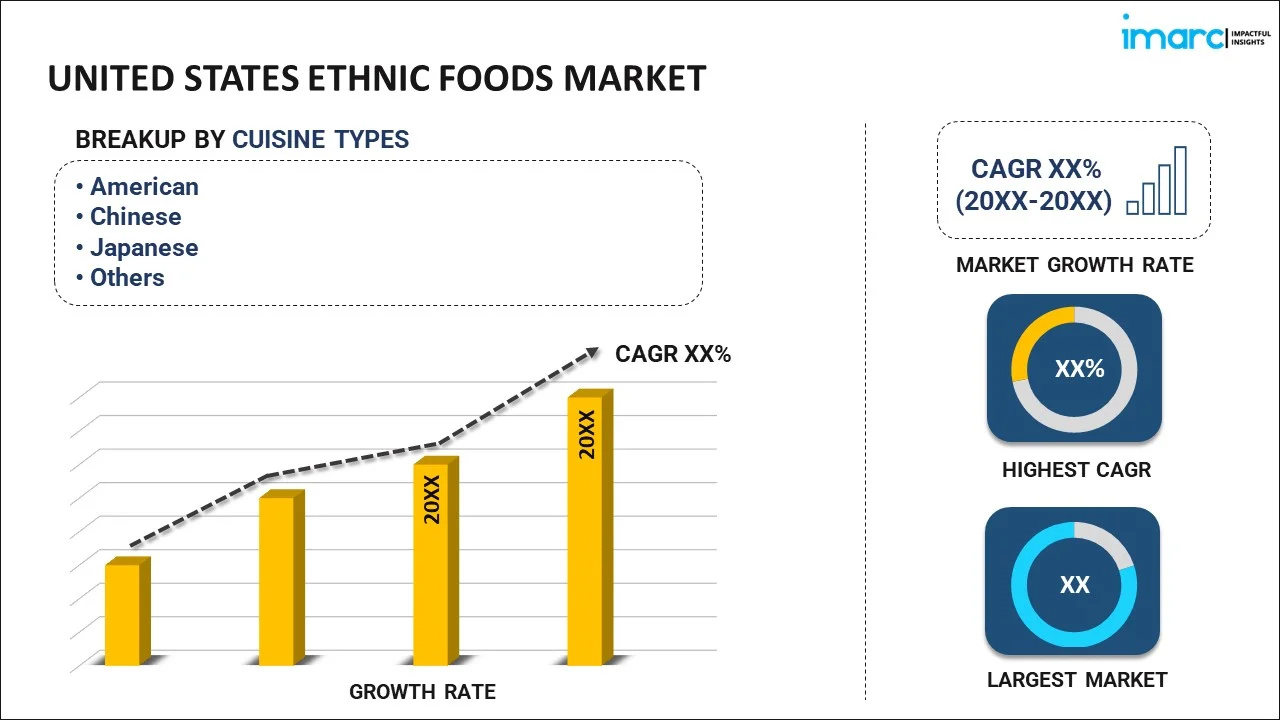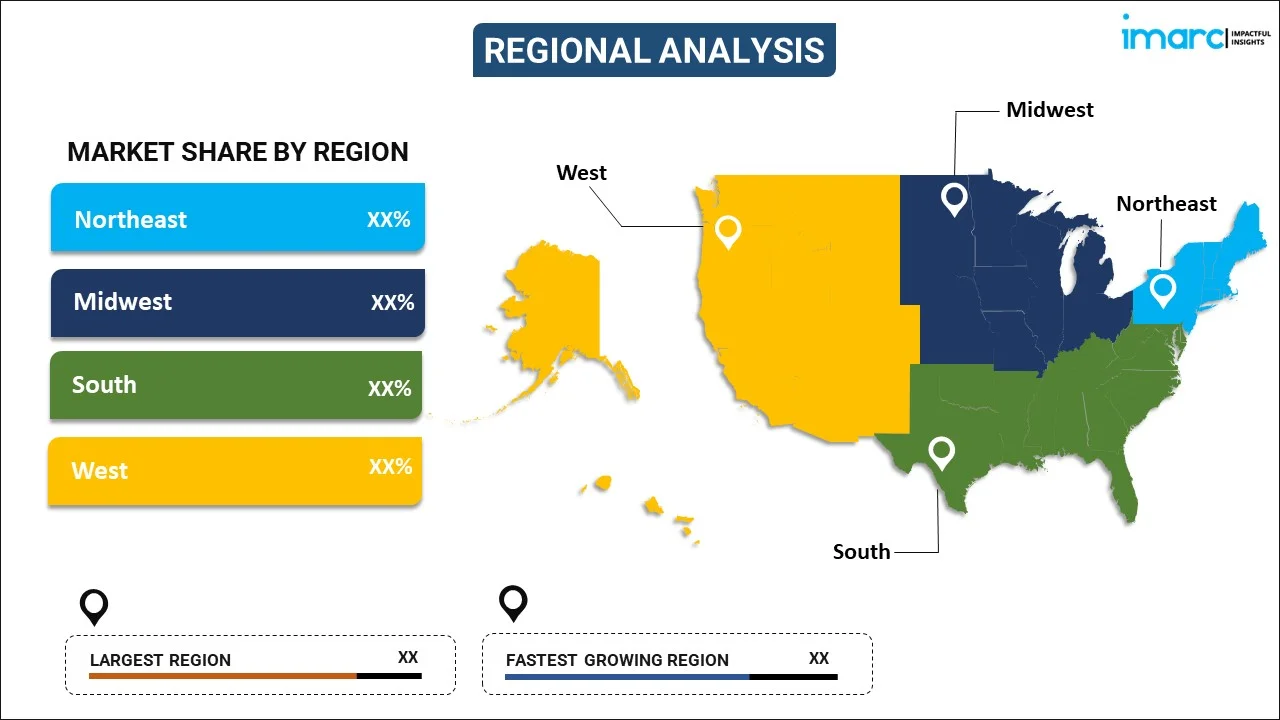
United States Ethnic Foods Market Report by Cuisine Type (American, Chinese, Japanese, Mexican, Italian, and Others), Food Type (Vegetarian, Non-Vegetarian), Distribution Channel (Food Services, Retail Stores), and Region 2025-2033
United States Ethnic Foods Market Size, Share & Analysis:
The United States ethnic foods market size reached USD 29.2 Billion in 2024. Looking forward, IMARC Group expects the market to reach USD 56.1 Billion by 2033, exhibiting a growth rate (CAGR) of 7.3% during 2025-2033. The growing health and wellness trends, increasing cultural diversity and immigration, rapid globalization and food accessibility, and the rising influence of celebrity chefs and food-related media, represent some of the key factors driving the market.
United States Ethnic Foods Market Insights:
- Major Market Drivers: As per the United States ethnic foods market analysis, the market is being fueled by growing cultural diversity, expanded interest in international foods, and changing consumer tastes toward bold, experience-oriented dining. Convenience, accessibility, and interest are also driving trial and repeat consumption of ethnic food options.
- Key Market Trends: Current trends also involve the emergence of fusion foods, plant-based additions, and authenticity and geography focus. Ethnic foods are more commonly available in ready-to-eat (RTE) products and restaurant-style dishes that fit changing lifestyles and meal patterns of consumers.
- Competitive Landscape: The competitive landscape is a combination of mainstream ethnic food manufacturers and big food firms moving into international cuisine niches. Authenticity, health-oriented formulations, and innovative packages achieve differentiation, while regional identity and storytelling are employed for building consumer trust.
- Challenges and Opportunities: It is challenging to preserve authenticity while complying with mainstream flavors. Nevertheless, there are opportunities in building retail presence, developing health-conscious alternatives, and utilizing online platforms to provide less familiar cuisines to a broader population, creating increased market participation and discovery.
|
Report Attribute
|
Key Statistics
|
|---|---|
|
Base Year
|
2024 |
|
Forecast Years
|
2025-2033 |
|
Historical Years
|
2019-2024
|
| Market Size in 2024 | USD 29.2 Billion |
| Market Forecast in 2033 | USD 56.1 Billion |
| Market Growth Rate (2025-2033) | 7.3% |
Ethnic foods encompass a broad spectrum of culinary delights that originate from various cultural and regional traditions around the world. These foods are distinct in flavor, preparation techniques, and ingredients, representing the cultural heritage and culinary expertise of different ethnic or cultural groups. From fragrant Indian curries to savory Italian pasta dishes, spicy Mexican tacos to delicate Japanese sushi, and flavorful Middle Eastern kebabs to aromatic Thai stir-fries, ethnic foods offer a diverse and rich array of tastes and experiences. Restaurants and food manufacturers are also catering to this demand, incorporating ethnic dishes into their menus and product offerings. Additionally, the availability of authentic ethnic ingredients in supermarkets and online stores is making it easier for consumers to experiment with and prepare these dishes at home. Ethnic foods not only offer a delicious dining experience but also serve as a medium for cultural exchange and appreciation. They provide a window into the history, traditions, and values of diverse communities, fostering a sense of connection and understanding among people from different backgrounds.
United States Ethnic Foods Market Trends:
Fusion Flavors Propelling Innovation and Demand
Combining international culinary customs with American foodways is becoming a characteristic trend in United States ethnic foods development. Consumers are being attracted more and more to fusion foods, which combine disparate ethnic elements into new, accessible formats. For instance, in July 2025, the Minnesota State Fair debuted 33 new foods and eight vendors, including ethnic fusions by Holy Land (tandoori quesaratha), Union Hmong Kitchen (shrimp toast), and Soul Bowl (chicken-fried bacon fries), as examples of emerging multicultural innovation in U.S. food experiences. Moreover, whether it is Korean barbecue tacos, Indian-spiced pizzas, or Mediterranean bowls, these fusions provide consumers with familiar formats filled with vibrant global flavor. This innovation not only gets consumers to try new taste profiles but also encourages more experimentation in home cooking and foodservice menus. With younger generations, especially millennials and Gen Z, showing increasing interest in international food experiences, fusion foods are emerging as a gateway to genuine ethnic cuisine. These innovative transformations are playing a strong role in United States ethnic foods market growth, especially in urban and multicultural areas. Consequently, fusion trends are likely to take center stage in influencing product development, expanding the market base, and strengthening long-term consumer involvement with ethnic foods.
Mainstreaming of Authentic Global Cuisines
Authentic ethnic foods are no longer limited to specialty stores or ethnic communities. With rising cultural exposure from media, travel, and migration, traditional global cuisines are becoming mainstream in American eating. Ingredients previously thought to be exotic—like gochujang, za'atar, paneer, or injera—are now creeping into regular grocery baskets and restaurant menus. This mainstreaming is a sign of a larger transformation in consumer taste, where depth of flavor, regional authenticity, and preparation methods are becoming more desired. Increased demand for regional authenticity is also leading manufacturers and retailers to invest in transparent labeling and sourcing to build credibility. As global foods find more representation in supermarkets, meal kits, and fast-service eating, United States ethnic foods market share is on the verge of growth. The transition from novelty to mainstreaming is reinforcing ethnic foods' position as a staple in American eating patterns, shifting the category from fad curiosity to a habitual consumption behavior.
Health-Conscious Reinterpretations of Traditional Recipes
Health and wellness concerns are increasingly playing a role in the development of ethnic cuisine in the U.S., resulting in retooling classic recipes to suit contemporary nutritional trends. Most consumers today look for ethnic dishes that preserve original taste but present advantages like less fat, less sodium, more protein, or plant-based. Foods like, baked samosas, quinoa-based tabbouleh, or dairy-free thai curries are emerging as top picks among health-oriented shoppers. This trend follows the trend of the larger consumer shift toward clean-label, nutrient-dense foods that are not at the expense of taste or cultural heritage. Additionally, the use of functional ingredients—such as turmeric, ginger, or fermented ingredients—fits well with health-conscious lifestyles. These re-formulations are serving a niche that appreciates both tradition and nutrition, hence fueling continued market analysis. Consequently, the capacity to combine cultural heritage with health priorities is propelling United States ethnic foods market demands across various demographics.
United States Ethnic Foods Market Segmentation:
IMARC Group provides an analysis of the key trends in each segment of the United States ethnic foods market report, along with forecasts at the country level for 2025-2033. Our report has categorized the market based on cuisine type, food type, and distribution channel.
Cuisine Type Insights:

To get more information on this market, Request Sample
- American
- Chinese
- Japanese
- Mexican
- Italian
- Others
The report has provided a detailed breakup and analysis of the market based on the cuisine type. This includes American, Chinese, Japanese, Mexican, Italian, and others.
Food Type Insights:
- Vegetarian
- Non-Vegetarian
A detailed breakup and analysis of the market based on the food type has also been provided in the report. This includes vegetarian and non-vegetarian. According to the report, xx accounted for the largest market share.
Distribution Channel Insights:
- Food Services
- Retail Stores
A detailed breakup and analysis of the market based on the distribution channel has also been provided in the report. This includes food services and retail stores.
Regional Insights:

- Northeast
- Midwest
- South
- West
The report has also provided a comprehensive analysis of all the major regional markets, which include Northeast, Midwest, South, and West.
Competitive Landscape:
The report has also provided a comprehensive analysis of the competitive landscape in the United States ethnic foods market. Competitive analysis such as market structure, key player positioning, top winning strategies, competitive dashboard, and company evaluation quadrant has been covered in the report. Also, detailed profiles of all major companies have been provided.
Latest News and Developments:
- In July 2025, Tacos on the Street, a popular Puerto Vallarta Mexican street taco chain, will expand into the United States by opening its flagship U.S. store in San Antonio, Texas, in July 2025. The eatery will serve authentic dishes such as carne asada, hand-pressed tortillas, house salsas, and Mexican drinks, as it begins its U.S. growth.
- In July 2025, Nigeria-based fast-casual chain Nuli broke ground on its initial U.S. restaurant in Washington, D.C.'s central business district. Opening in August 2025 at The Square food hall, Nuli will offer nutritious African-influenced wraps, bowls, and salads featuring local ingredients and honoring diverse pan-African traditions.
- In May 2025, a new Cantonese-themed food truck called Wok Wey was opened in San Antonio, which serves up classic wok-fried foods like char siu pork and fried rice. The opening is an indication of increasing demand for regional Asian food in the growth United States ethnic foods market.
United States Ethnic Foods Market Report Coverage:
| Report Features | Details |
|---|---|
| Base Year of the Analysis | 2024 |
| Historical Period | 2019-2024 |
| Forecast Period | 2025-2033 |
| Units | Billion USD |
| Scope of the Report | Exploration of Historical and Forecast Trends, Industry Catalysts and Challenges, Segment-Wise Historical and Predictive Market Assessment:
|
| Cuisine Types Covered | American, Chinese, Japanese, Mexican, Italian, Others |
| Food Types Covered | Vegetarian, Non-Vegetarian |
| Distribution Channels Covered | Food Services, Retail Stores |
| Regions Covered | Northwest, Midwest, South, West |
| Customization Scope | 10% Free Customization |
| Post-Sale Analyst Support | 10-12 Weeks |
| Delivery Format | PDF and Excel through Email (We can also provide the editable version of the report in PPT/Word format on special request) |
Key Benefits for Stakeholders:
- IMARC’s report offers a comprehensive quantitative analysis of various market segments, historical and current market trends, market forecasts, and dynamics of the United States ethnic foods market from 2019-2033.
- The research study provides the latest information on the market drivers, challenges, and opportunities in the United States ethnic foods market.
- Porter's five forces analysis assist stakeholders in assessing the impact of new entrants, competitive rivalry, supplier power, buyer power, and the threat of substitution. It helps stakeholders to analyze the level of competition within the United States ethnic foods industry and its attractiveness.
- Competitive landscape allows stakeholders to understand their competitive environment and provides an insight into the current positions of key players in the market.
Key Questions Answered in This Report
The ethnic foods market in the United States was valued at USD 29.2 Billion in 2024.
The United States ethnic foods market is projected to exhibit a (CAGR) of 7.3% during 2025-2033, reaching a value of USD 56.1 Billion by 2033.
Primary drivers of the United States ethnic foods market are increased cultural diversity, greater consumer interest in global flavors, and more international cuisines made accessible through travel and media. Convenience, healthful reformulations, and amplified availability across retail channels further fuel consumer demand for diverse and flavorful meal choices.
Need more help?
- Speak to our experienced analysts for insights on the current market scenarios.
- Include additional segments and countries to customize the report as per your requirement.
- Gain an unparalleled competitive advantage in your domain by understanding how to utilize the report and positively impacting your operations and revenue.
- For further assistance, please connect with our analysts.
 Request Customization
Request Customization
 Speak to an Analyst
Speak to an Analyst
 Request Brochure
Request Brochure
 Inquire Before Buying
Inquire Before Buying




.webp)




.webp)












